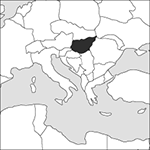
Source: MAPS IN MINUTES™ © RH Publications (1997)
Capital:
Budapest
Area:
93,028 sq km (35,918 sq miles)
Population:
9,939,470 (2013 est)
Currency:
1 forint = 100 filler
Religions:
Roman Catholic 37.2%; Calvinist 11.6%; Lutheran 2.2%
Ethnic Groups:
Magyar 92.3%; Roma 1.9%
Languages:
Hungarian (official); minority languages
International Organizations:
UN; OSCE; Council of Europe; NATO; EU; OECD; WTO
A country in central Europe, bounded by Slovakia on the north, Romania and Ukraine on the east, Slovenia, Croatia, and Serbia on the south, and Austria on the west.
Physical
From north to south through the centre flows the Danube, in a broad plain (the puszta) which extends eastwards to the river Tisza across pastureland and areas suited to agriculture. West of the river is the Bakony Forest consisting of mainly deciduous trees, Lake Balaton (the largest and shallowest lake in central Europe), and a fertile plateau with granite hills.
Economy
Machinery and equipment provide about half of Hungary’s export earnings, with other manufacture providing about one-third and food products under one-tenth. The principal crops are cereals, sunflower seed, potatoes, and sugar beet; the principal industries are mining, metallurgy, and construction materials. Hungary has successfully made the transition from a centrally planned to a market economy
History
The region comprising the Roman provinces of Pannonia and Dacia was overrun by Germanic tribes in the Dark Ages and then conquered by Charlemagne. By 896 elected Magyar Arpad leaders ruled and Hungary emerged as the centre of a strong Magyar kingdom in the late Middle Ages. A Mongol invasion devastated the population in 1241 and the Arpad line ended in 1301. Thereafter, the crown was usually passed to a foreigner. The advance of the Ottoman empire threatened, especially after the battle of Nicopolis in 1396, when Sigismund, King of Hungary, was defeated by the Turks. John Hunyadi (died 1456) and his son Matthias Corvinus brought revival, but in 1490 the Jagiellons gained the throne, and, in 1515, a Habsburg claim arose. The disastrous defeat of the Hungarian king, Louis II, at Mohács (1526), led to the partition of Hungary between the Habsburgs and the Ottomans although Transylvania retained its independence. By 1711 all of Hungary had come under Habsburg rule and remained part of the Habsburg empire until 1919.
In the 19th century Magyar nationalism was antagonized by the repressive policies of Metternich, leading to rebellion under Kossuth in 1848. The Austrians, with Russian help, reasserted control. After defeat by Prussia the Austrians compromised with the Magyars in 1867, setting up Austria-Hungary, or the Dual Monarchy, which was first and foremost an alliance of Magyars and Austrian Germans against the Slav nationalities. Defeat in World War I led to revolution and independence, first under Károlyi’s democratic republic, then briefly under Béla Kun’s communist regime. Dictatorship followed in 1920 under Horthy, and lasted until 1944. Allied to the Axis Powers in World War II, defeat brought Soviet domination and a communist one-party system. This was resented and, briefly, in 1956, the Hungarian Revolution saw resistance to the Soviet Union. Hungary experienced some degree of liberalization during the latter years of János Kádár’s regime (1956–88). Demonstrations in Budapest in 1988 resulted in multiparty politics being restored. Elections brought to power the Hungarian Democratic Forum (MDF) early in 1990; but after the collapse of COMECON, trade fell and there was rising unemployment and popular discontent. Refugees from Romanian Transylvania and from disintegrating Yugoslavia caused additional problems. A programme of ambitious reforms to revive the economy and introduce a free-market system were launched in 1990. However, continued economic recession and domestic political problems resulted, in the general election of May 1994, in the heavy defeat of the MDP. A new coalition, led by the Hungarian Socialist Party under Gyula Horn, took office. A small degree of economic growth was recorded in 1995, despite a sense of economic crisis in the country, which led to the introduction of economic austerity measures. In 1998 the reformist Fidesz movement won elections and Viktor Orban became Prime Minister; following the Socialist Party’s victory in 2002, he was succeeded by Peter Medgyessy (2002–04) and Ferenc Gyurcsány (2004–06). Hungary joined NATO in 1999 and the European Union in 2004. Austerity measures were again introduced in 2006 to control Hungary’s budget deficit, but the Credit Crunch created a crisis: Hungary was unable to borrow from the global financial markets to refinance its debt and in 2008 agreed to a bailout from the IMF, EU, and World Bank. Gyurcsány resigned in 2009 and a landslide Fidesz victory in the 2010 elections returned Orban as Prime Minister. Fidesz used its dominance to enact sweeping reforms, including a new constitution (2012) that attracted international criticism of its illiberal character. Fidesz was re-elected in 2014 and 2018, and the increasingly nationalistic Orban has moved Hungary closer to Russia and away from the EU mainstream, particularly on immigration policy.
- Pearson residual
- Pearson symbol
- Pearson’s product moment correlation coefficient
- Peary, Robert Edwin (1856–1920)
- peasant
- Peasants’ Revolt (1381)
- Peasants’ War (1524–26)
- peat
- peat-borer
- peat moss
- peat podzol
- peat soil
- pebble
- pebi-
- pecan
- peck order
- pecten
- pectic substance
- pectin
- pectolite
- pectoral fins
- pectoral girdle
- peculiar galaxy
- peculiar motion
- peculiar star